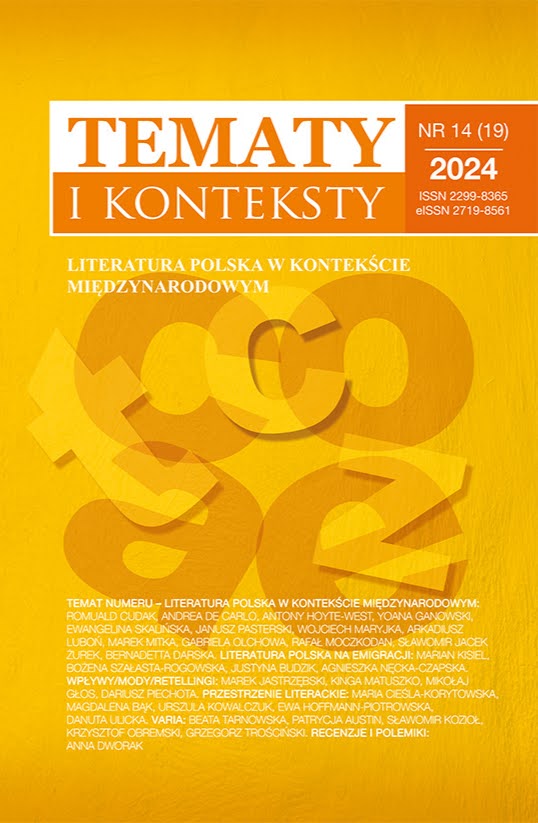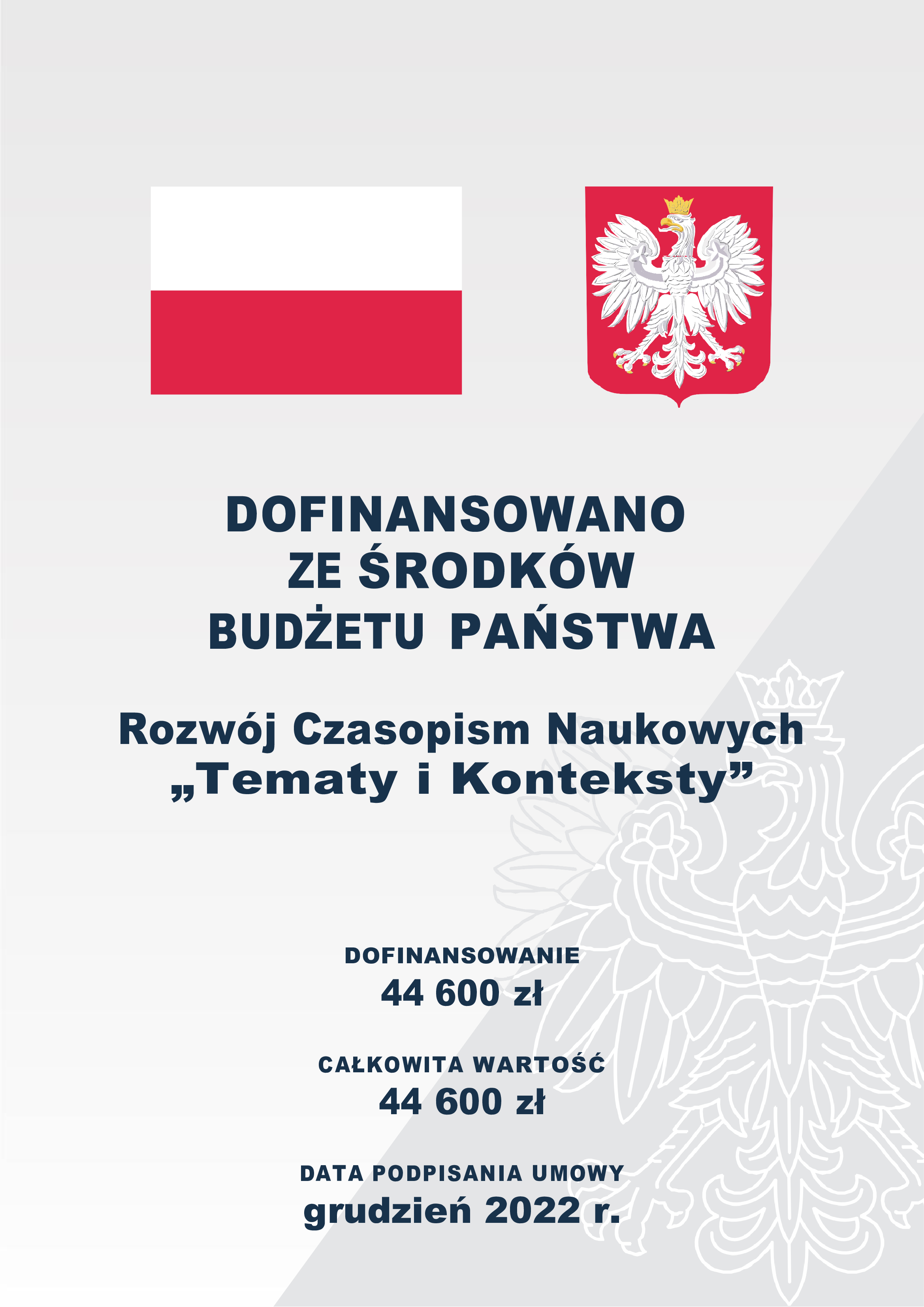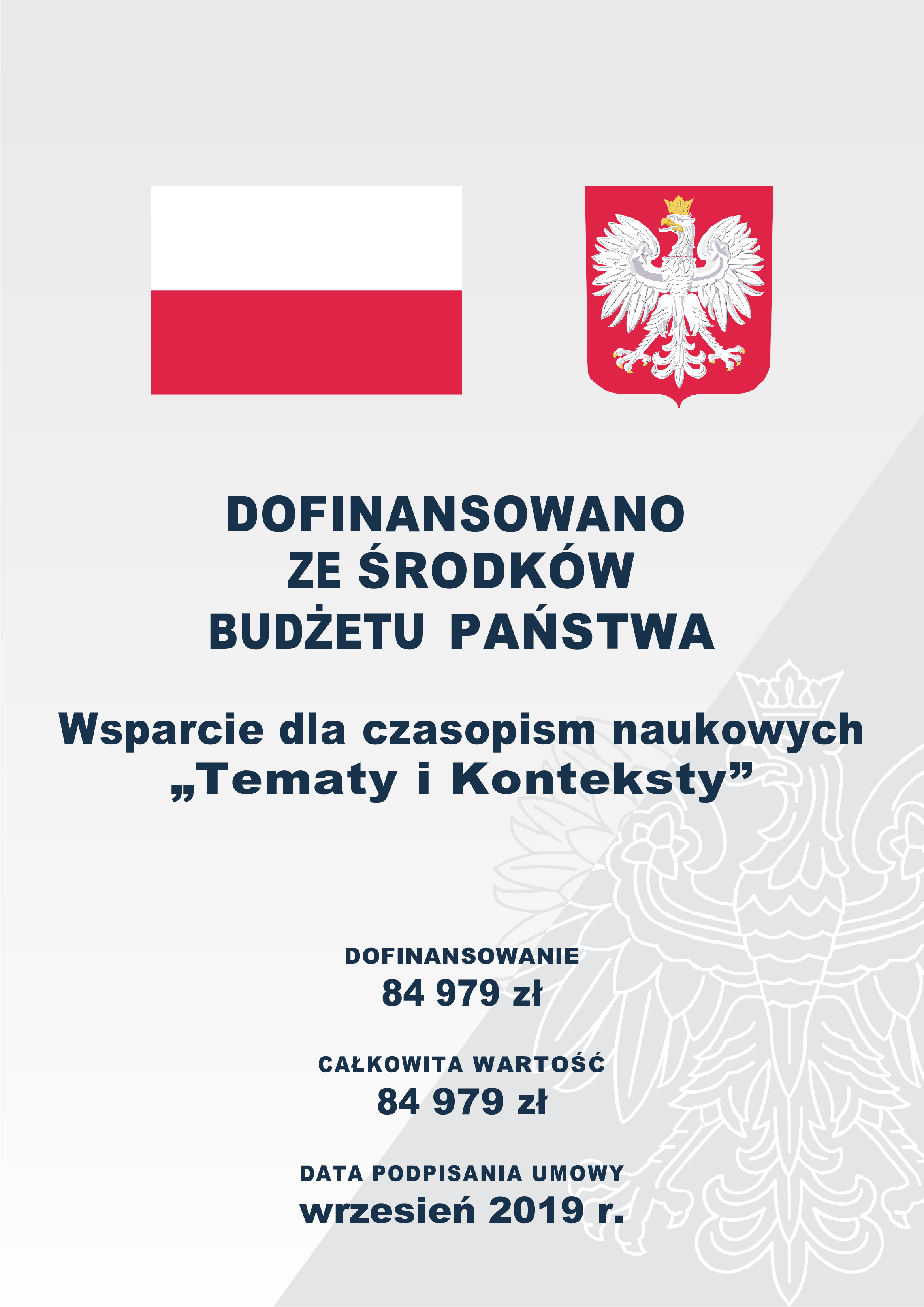The Covenant with the desert – based on the volume "Nof galui einayim" by Yehuda Amichai
DOI:
https://doi.org/10.15584/tik.2024.27Keywords:
Judean Desert, the poetry of Yehuda Amichai, Israeli literatureAbstract
The article „The Covenant with the desert – based on the volume Nof galui einayim [Open Eyed Land] by Yehuda Amichai” presents the image of the Judean Desert conveyed in poems of the Israeli poet Yehuda Amichai. In this volume, the Judean Desert is not only a biological and geographical category, but above all a part of the poet's inner experience. It is a symbolic space, saturated with both personal memories and the collective memory of many generations of Jews, from the times of Masada till the 20th century. In this desert, Amichai, referring to the figure of the Absent God, in whom he had already lost his faith, conducts a dialogue with the Jewish religious tradition. However, what attracts him the most to the desert is its silence and emptiness, evoking openness to the Inexpressible, to the world of rocks and minerals, and the prehistory of the Earth, more powerful than anthropology.
Downloads
References
Aberbach D., Religious Metaphor and Its Denial in the Poetry of Yehuda Amichai, „Judaism: A Quarterly Journal of Jewish Life and Thought” 2004, Summer, vol. 53, nr 3/4, s. 279–292.
Abramson G., Portrait of the Poet in a Landscape, w: The Experienced Soul. Studies in Amichai, ed. G. Abramson, London and New York: Routledge 2019, s. 57–69. DOI: https://doi.org/10.4324/9780429310768-6
Abramson G., The Writing of Yehuda Amichai: A Thematic Approach, Albany: State University of New York Press 1989. DOI: https://doi.org/10.1353/book10779
Almog O., The Sabra: The Creation of the New Jew, transl. by H. Watzman, Berkeley: University of California Press 2000. DOI: https://doi.org/10.1525/california/9780520216426.001.0001
Amichai Y., Nof galuj ejnajim, Landschaft Offenen Auges, Open Eyed Land, Hebrew, English, German; photos: F. Sz. Wieler, Tel Aviv: Schocken Publishing House 1992.
Assmann J., Kultura pamięci, przeł. A. Kryczyńska-Pham, w: Pamięć zbiorowa i kulturowa. Współczesna perspektywa niemiecka, red. M. Saryusz-Wolska, Kraków 2009.
Baudrillard J., Ameryka, przeł. R. Lis, Warszawa 2011.
Ben-David O., Tiyul (Hike) as an Act of Consecration of Space, w: Grasping Land: Space and Place in Contemporary Israeli Discourse and Experience, eds. E. Ben-Ari, Y. Bilu, Albany: State University of New York Press 1997, s. 129–145.
Ben-Dor Derimian I., From the Conquest of the Desert to Sustainable Development. The representation of the Negev in the public discourse in Israel, Berlin: LIT Verlag 2021.
Bielik-Robson A., «Uśmiech Widma bez Ciała: kabalistyczna baśń z Derridą w tle», „Teksty Drugie” 2016, nr 2, s. 15–37; http://journals.openedition.org/td/7315 (dostęp: 23.09.2023). DOI: https://doi.org/10.18318/td.2016.2.2
Bloch Ch., Kronfeld Ch., Amichai’s Counter-Theology: Opening „Open Closed Open”, „Judaism. A Quarterly Journal of Jewish Life and Thought” 2000, Spring, vol. 49, nr 2, s. 153–163.
Cohen E., The City in the Zionist Ideology, Hebrew University of Jerusalem 1970, https://en.urbanstudies.huji.ac.il/publications/city-zionist-ideology (dostęp: 24.08.2023).
Cohen J., Voices of Israel. Essays and the Interviews with Yehuda Amichai, A. B. Yehoshua, T. Carmi, Aharon Appelfeld and Amos Oz, State University of New York Press 1990. DOI: https://doi.org/10.1353/book10482
Czaja D., Lekcje ciemności, Wołowiec 2009.
Desert oasis through the eyes of a blind poet – Israel in Translation, https://tlv1.fm/arts-culture/2015/04/29/a-desert-oasis-through-the-eyes-of-a-blind-poet-israel-in-translation/ (dostęp: 16.08.2023).
Flawiusz J., Wojna żydowska, przeł. z jęz. grec. J. Radożycki, Warszawa 1991.
Forstner D., Świat symboliki chrześcijańskiej, tłum. i oprac. W. Zakrzewska, P. Pachciarek, R. Turzyński, Warszawa 1990.
Ganan M., Hazman beszirat Jehuda Amichaj [Czas w poezji Jehudy Amichaja], https://www.e-mago.co.il/Editor/literature-3108.htm (dostęp: 21.08.2023).
Hałas S., Pustynia miejscem próby i spotkania z Bogiem. Wybrane zagadnienia biblijnej teologii pustyni, Kraków 1999.
Jankowski S., Symbolika pasterza w tekstach biblijnych, „Studia Włocławskie” 2015, nr 17, s. 109–120.
Jasionowicz S., Pustka we współczesnym doświadczeniu poetyckim, Kraków 2009.
Jiszuw haNegew, 1900–1960, ed. M. Naor, Jerusalem: Yad Izhak Ben-Zvi 1985.
Johnson P., Historia Żydów, przeł. M. Godyń, M. Wójcik, A. Nelicki, Kraków 1993.
Jonaj L., Jad noga`at bejad: hameszorerim Erez Biton weJehuda Amichaj baMidbar Jehuda [Dłoń dotykająca dłoni: poeci Erez Biton i Jehuda Amichaj na Pustyni Judzkiej], https://leoryonai.com/ (dostęp: 16.08.2023).
Kociatkiewicz J., Kostera M., Antropologia pustych przestrzeni, w: Pisanie miasta – czytanie miasta, red. A. Zeidler-Janiszewska, Poznań 1997, s. 73–81.
Kopaliński W., Słownik symboli, Warszawa 1991.
Leeuw G. van der, Fenomenologia religii, przeł. z niem. J. Prokopiuk, Warszawa 1997.
Leksykon symboli. Herder, oprac. M. Oesterreicher-Mollwo, przeł. J. Prokopiuk, Warszawa 1992.
Lurker M., Słownik obrazów i symboli biblijnych, przeł. bp K. Romaniuk, Poznań 1989.
Meiri G., Jamim szeawdu lo joszwu bamisztara. Humor beszirat Jehuda Amichaj [Dni, które się zgubiły, nie są zwracane na policji. Humor w poezji Jehudy Amichaja], https://www.poetryplace.org/tag/ (dostęp: 11.08.2023).
Michałowska T., Poetyka i poezja. Studia i szkice staropolskie, Warszawa 1982.
Midbar Jehuda [Pustynia Judzka], https://he.wikipedia.org/wiki (dostęp: 21.08.2023).
Millan Jr., A. M. L., The Desert in the Tradition of Israel, Pamplona: Universidad de Navarra 1997, https://dadun.unav.edu › CDT_XXXII_01 (dostęp: 8.08.2023).
Omer-Sherman R., Israel in Exile: Jewish Writing and the Desert, Urbana and Chicago: University of Illinois Press 2006.
Porat Ch., Jehuda Amichaj – ikwot nof haNegew hacfoni besziraw [Jehuda Amichaj – ślady pejzażu północnego Negewu w jego wierszach], https://www.news1.co.il/Archive/0026-D-118325-00.html (dostęp: 8.08.2023).
Rosenthal R., Jehuda Amichaj, haisz szediber szira [Jehuda Amichaj, człowiek, który mówił poezją], https://www.ruvik.co.il › ירוביג-הפש (dostęp: 21.08.2023).
Rzepińska M., Historia koloru w dziejach malarstwa europejskiego, Kraków 1983.
Scholem G., Mistycyzm żydowski i jego główne kierunki, przeł. M. Galas, wstęp I. Kania, Warszawa 1997.
Słownik języka polskiego PWN, https://sjp.pwn.pl/sjp/strona;2524638.html (dostęp: 1.10.2023).
Stamelman R., Lost Beyond Telling. Representations of Death and Absence in Modern French Poetry, Ithaca and London: Cornell University Press 1990.
Ryken L., Wilhoit J. C., Longman T., Słownik symboliki biblijnej. Obrazy, symbole, motywy, metafory, figury stylistyczne i gatunki literackie w Piśmie Świętym, red. ks. W. Chrostowski, Warszawa 2010.
Tuan Y-F., The Desert and I: A Study in Affinity, „Michigan Quarterly Review”, Winter 2001, vol. XL, no. 1, quod.lib.umich.edu/m/mqr/act2080.0040.102?rgn (dostęp: 29.06. 2023).
Tuan Y-F., The Desert and the Sea, “New Mexico Quarterly” Summer 1963, s. 329–331.
Tynan A., The Desert in Modern Literature and Philosophy: Wasteland Aesthetics, Edinburgh University Press 2020. DOI: https://doi.org/10.1515/9781474443371
Weiss T., ‘Gods Change’: The Deconstruction of the Transcendent God and the Reconstruction of the Mythical Godhead in Yehuda Amichai’s ‘Open Closed Open’, w: Negative Theology as Jewish Modernity, ed. M. Fegenblat, Bloomington: Indiana University Press 2017, s. 323–334. DOI: https://doi.org/10.2307/j.ctt1zxxzkg.18
Yadin Y., Masada – Herod’s fortress and the zealots last stand, transl. from Hebrew by M. Pearlman, London: Weidenfeld and Nicolson 1966.
Yehuda Amichai, The Art of Poetry No. 44. Interviewed by Lawrence Joseph, „The Paris Review” 1992, Spring, nr 122, https://www.theparisreview.org/interviews/2095/the-art-of-poetry-no-44-yehuda-amichai (dostęp: 12.09. 2023).
Zerubavel Y., The Desert and the Settlement as Symbolic Landscapes in Modern Israeli Culture, w: Jewish Topographies Visions of Space, Traditions of Place, ed. J. Brauch, A. Lipphardt, A. Nocke, London and Aldershot: Ashgate Press 2008, s. 201–222.
Zerubavel Y., Desert in the Promised Land, Stanford University Press 2019. DOI: https://doi.org/10.1515/9781503607606
Zerubavel Y., The Death of Memory and the Memory of Death: Masada and the Holocaust as Historical Metaphors, „Representations” 1994, nr 45 (Winter), s. 72–100. DOI: https://doi.org/10.2307/2928603
Zerubavel Y., The Politics of Remembrance and the Consumption of Space: Masada in Israeli Memory, w: Memory and the Impact of Political Transformation in Public Space, ed. by D. Walkowitz, L. M. Knauer, Duke University Press 2004, s. 233–252. DOI: https://doi.org/10.2307/j.ctv11vc8nx.16
Ziemia, oprac. M. Jakubczak, w: Estetyka czterech żywiołów: ziemia, woda, ogień, powietrze, red. K. Wilkoszewska, Kraków 2002, s. 22–69.
Downloads
Published
How to Cite
Issue
Section
Categories
License
Copyright (c) 2024 Tematy i Konteksty

This work is licensed under a Creative Commons Attribution-NonCommercial-NoDerivatives 4.0 International License.




